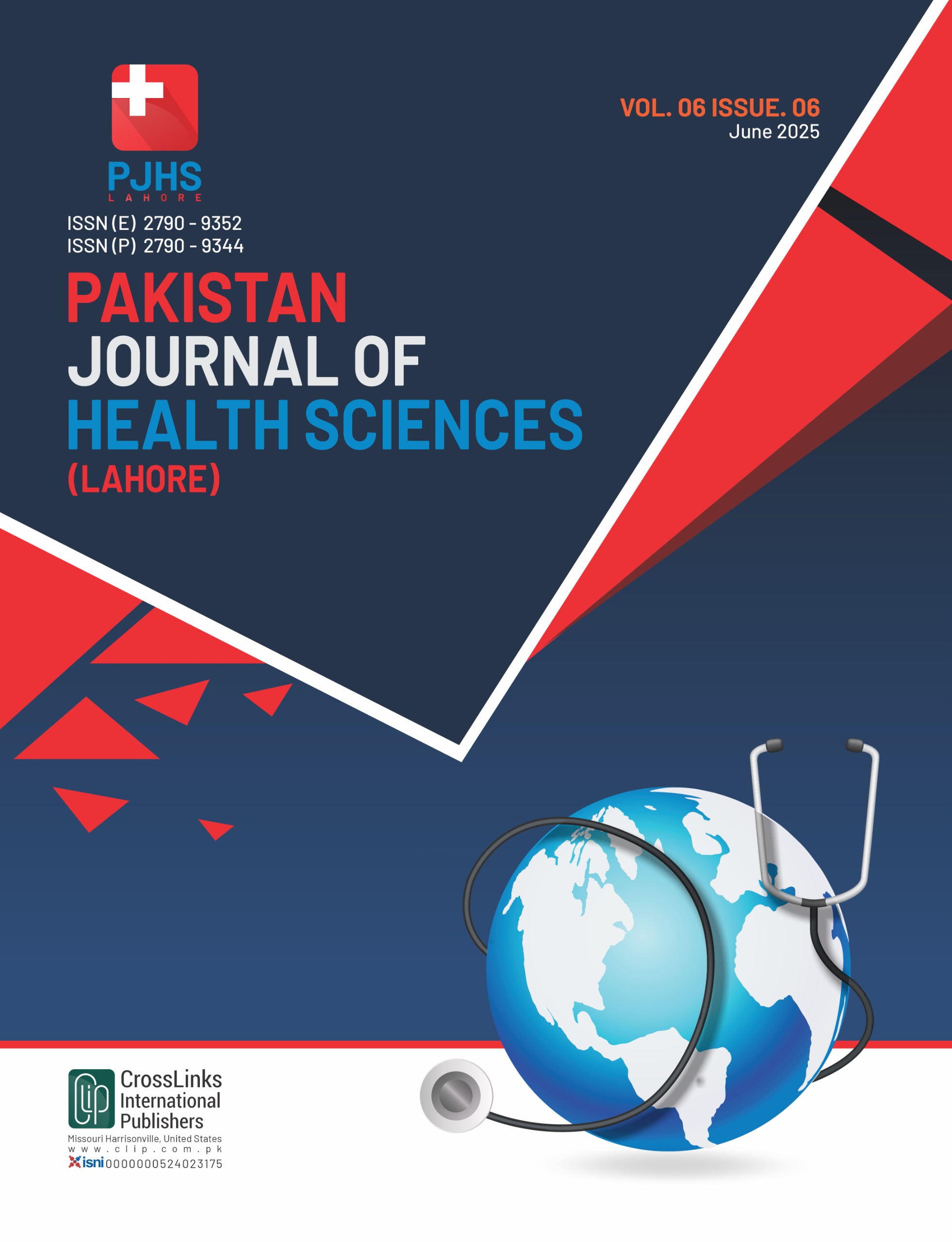Association of Cutaneous Manifestations with Undiagnosed Diabetes Mellitus in Adults
Cutaneous Manifestations with Undiagnosed Diabetes Mellitus
DOI:
https://doi.org/10.54393/pjhs.v6i6.3195Keywords:
Diabetes Mellitus, Pre-Diabetes, Cutaneous Markers, Acanthosis Nigricans, Skin Tags, XerosisAbstract
Diabetes mellitus (DM) remains underdiagnosed in resource-limited settings, where access to laboratory screening is constrained. Cutaneous manifestations may serve as visible, cost-effective indicators. Objectives: To determine the association between characteristic skin lesions (acanthosis nigricans, skin tags, xerosis) and undiagnosed diabetes in adults. Methods: A cross-sectional study involving 400 participants was conducted at a Teaching Hospital with adult patients without known diabetes (aged 18–70) attending dermatology and general medicine clinics. Detailed dermatological examinations documented predefined skin manifestations, while biochemical assessments (fasting plasma glucose, HbA1c, and oral glucose tolerance test) classified participants into normoglycemic, pre-diabetic (IFG/IGT), or diabetic groups per ADA criteria. Statistical analysis was done on SPSS version 26.0. Results: The prevalence of cutaneous markers was significantly higher in prediabetes and diabetes groups (p<0.001). Acanthosis nigricans was present in 61.4% of cases, nearly eight times more prevalent than in normoglycemic individuals (8.1%). Similarly, multiple skin tags (≥5) affected 52.9% of diabetics compared to just 12.4% of controls, while xerosis showed a fourfold increase from 9.5% in normoglycemic subjects to 44.3% in diabetics. Conclusions: It was concluded that specific dermatological manifestations exhibit a robust correlation with undiagnosed diabetes and pre-diabetes. Incorporating cutaneous markers into routine clinical examinations may enhance early detection, particularly in resource-limited settings.
References
Abdul Basit K, Fawwad A, Mustafa N, Davey T, Tahir B, Basit A. Changes in the prevalence of diabetes, prediabetes and associated risk factors in rural Baluchistan; a secondary analysis from repeated surveys (2002–2017). PLOS ONE. 2023 Apr; 18(4): e0284441. doi: 10.1371/journal.pone.0284441. DOI: https://doi.org/10.1371/journal.pone.0284441
Lam AA, Lepe A, Wild SH, Jackson C. Diabetes comorbidities in low- and middle-income countries: an umbrella review. Journal of Global Health. 2021 Jul; 11: 04040. doi: 10.7189/jogh.11.04040. DOI: https://doi.org/10.7189/jogh.11.04040
Nellaiappan K, Preeti K, Khatri DK, Singh SB. Diabetic complications: an update on pathobiology and therapeutic strategies. Current Diabetes Reviews. 2022 Jan; 18(1): 31-44. doi: 10.2174/1573399817666210309104203. DOI: https://doi.org/10.2174/1573399817666210309104203
Cousin E, Schmidt MI, Ong KL, Lozano R, Afshin A, Abushouk AI et al. Burden of diabetes and hyperglycaemia in adults in the Americas, 1990–2019: a systematic analysis for the Global Burden of Disease Study 2019. The lancet Diabetes and endocrinology. 2022 Sep; 10(9): 655-67.
Leal JM, Souza GH, Marsillac PF, Gripp AC. Manifestações cutâneas associadas a doenças sistêmicas–Parte II. Anais Brasileiros de Dermatologia. 2021 Nov; 96(6): 672-87. doi: 10.1016/j.abd.2021.06.003.
Rafat Lotfy A, Atef Shokry M, Genedy AA. Pathophysiology of Insulin Resistance and Related Skin Diseases. Sohag Medical Journal. 2025 Jan; 29(1): 16-23. doi: 10.21608/smj.2024.331502.1504. DOI: https://doi.org/10.21608/smj.2024.331502.1504
Bharath LP, Rockhold JD, Conway R. Selective autophagy in hyperglycemia-induced microvascular and macrovascular diseases. Cells. 2021 Aug; 1 0(8): 2114. doi: 10.3390/cells10082114. DOI: https://doi.org/10.3390/cells10082114
Svoboda SA and Shields BE. Cutaneous manifestations of nutritional excess: Pathophysiologic effects of hyperglycemia and hyperinsulinemia on the skin. Cutis. 2021 Feb; 107(2): 74-8. doi: 10.12788/cutis.0173. DOI: https://doi.org/10.12788/cutis.0173
Okoro OE, Camera E, Flori E, Ottaviani M. Insulin and the sebaceous gland function. Frontiers in Physiology. 2023 Sep; 14: 1252972. doi: 10.3389/fphys.2023.1252972. DOI: https://doi.org/10.3389/fphys.2023.1252972
Vâță D, Stanciu DE, Temelie-Olinici D, Porumb-Andrese E, Tarcău BM, Grecu VB et al. Cutaneous Manifestations Associated with Diabetes Mellitus—A Retrospective Study. Diseases. 2023 Aug; 11(3): 106. doi: 10.3390/diseases11030106. DOI: https://doi.org/10.3390/diseases11030106
Chen VY, Siegfried LG, Tomic‐Canic M, Stone RC, Pastar I. Cutaneous changes in diabetic patients: Primed for aberrant healing?.Wound repair and regeneration. 2023 Sep; 31(5): 700-12. doi: 10.1111/wrr.13108. DOI: https://doi.org/10.1111/wrr.13108
Leal JM, Souza GH, Marsillac PF, Gripp AC. Manifestações cutâneas associadas a doenças sistêmicas–Parte II. Anais Brasileiros de Dermatologia. 2021 Nov; 96(6): 672-87. doi: 10.1016/j.abd.2021.06.003. DOI: https://doi.org/10.1016/j.abd.2021.06.003
David P, Singh S, Ankar R. A comprehensive overview of skin complications in diabetes and their prevention. Cureus. 2023 May; 15(5). doi: 10.7759/cureus.38961. DOI: https://doi.org/10.7759/cureus.38961
Eijaz S, Lalpuria S, Afzal M, Yasmeen A, Saleem S, Begum A. Prevalence of Complications Associated with Diabetes among Pakistani patients: a questionnaire-based Survey. Current Diabetes Reviews. 2022 Nov; 18(9): 87-95. doi: 10.2174/1573399818666220119100629. DOI: https://doi.org/10.2174/1573399818666220119100629
Ngo A, Froessl L, McWhorter JW, Perkison WB, Katta R. Diabetes detection and prevention in dermatology. Dermatology Practical and Conceptual. 2021 Oct; 11(4): e2021131. doi: 10.5826/dpc.1104a131. DOI: https://doi.org/10.5826/dpc.1104a131
Radu AM, Carsote M, Dumitrascu MC, Sandru F. Acanthosis nigricans: pointer of endocrine entities. Diagnostics. 2022 Oct; 12(10): 2519. doi: 10.3390/diagnostics12102519. DOI: https://doi.org/10.3390/diagnostics12102519
Leung AK, Lam JM, Barankin B, Leong KF, Hon KL. Acanthosis nigricans: an updated review. Current Pediatric Reviews. 2023 Feb; 19(1): 68-82. doi: 10.2174/1573396318666220429085231. DOI: https://doi.org/10.2174/1573396318666220429085231
Dixit S, Chandra A, Kariwala P, Sachan B, Singh BP, Pathak A et al. Utility of “Acanthosis Nigricans” and “Skin Tags” as a Screening Tool for Risk of Developing Noncommunicable Diseases: A Cross-sectional Study at a Health Facility in Lucknow (India). Annals of African Medicine. 2024 Jan; 23(1): 29-35. doi: 10.4103/aam.aam_90_23. DOI: https://doi.org/10.4103/aam.aam_90_23
Adibi N and Robati RM. Skin and metabolic syndrome: a review of the possible associations. Journal of Research in Medical Sciences. 2021 Jan; 26(1): 16. doi: 10.4103/jrms.JRMS_585_20. DOI: https://doi.org/10.4103/jrms.JRMS_585_20
Soesman TF, Budiastuti A, Malik DA, Widayati RI, Riyanto P. Systematic review and meta-analysis of the effectiveness of urea-based moisturizer on dry skin in diabetes mellitus patients with parameters stratum corneum hydration and xerosis assessment scale. Journal of Pakistan Association of Dermatologists. 2022 Jun; 32(2): 299-313.
Downloads
Published
How to Cite
Issue
Section
License
Copyright (c) 2025 Pakistan Journal of Health Sciences

This work is licensed under a Creative Commons Attribution 4.0 International License.
This is an open-access journal and all the published articles / items are distributed under the terms of the Creative Commons Attribution License, which permits unrestricted use, distribution, and reproduction in any medium, provided the original author and source are credited. For comments













